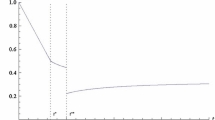Firms would like to capitalize on consumers' willingness to pay more for goods that use environmentally friendly production techniques, but have difficulty credibly conveying their environmental friendliness. One possible remedy is “ecolabeling,” where a third party certifies firms' products. To model this phenomenon, I analyzed a market characterized by asymmetric information in which firms decide whether to seek an ecolabel. Market equilibrium is discussed in three settings: where both technologies and outputs are fixed (so the only choice is whether to seek certification), where technologies are fixed but outputs are not, and where firms can choose both technology and output.
Similar content being viewed by others
References
F. Cairncross, Costing the Earth (Harvard University Press, Cambridge, MA, 1992).
T.N. Cason and L. Gangadharan, Environmental labeling and incomplete consumer information in laboratory markets, J. Environ. Econ. Manage. 43 (2002) 113–134.
B. Haji-Gazali and M. Simula, Certification schemes for all timber and timber products, in: Eco-labelling and International Trade, eds. S. Zarrilli, V. Jha and R. Vossenaar (Macmillan Press, New York, NY, 1997).
G. Levin, Consumers turning green: JWT survey, Advert. Age 61 (1990) 74.
J.F. Wasik, Green Marketing and Management: A Global Perspective (Blackwell Publishers, Inc., Cambridge, MA, 1996).
D. Winterhalter and D.C. Cassels, United States Hardwood Forests: Consumer Perceptions and Willingness to Pay (Purdue University Press, West Lafayette, IN, 1993).
H. Karl and C. Orwatt, Economic aspects of environmental labelling, in: International Yearbook of Environmental and Resource Economics, ed. T. Tietenberg (Edward Elgar, Cheltenham, UK, 2000).
OECD, Eco-labelling: Actual Effects of Selected Programs, OECD Working Paper vol. 5, no. 44 (Paris, 1997).
R. Vossenaar, Eco-labelling and international trade: the main issues, in: Eco-labelling and International Trade, eds. S. Zarrilli, V. Jha and R. Vossenaar (Macmillan Press, New York, NY, 1997).
C. Dosi and M. Moretto, Is ecolabeling a reliable environmental policy measure?, Environ. Resour. Econ. 18 (2001) 113–127.
A. Mattoo and H.V. Singh, Eco-labelling: policy considerations, Kyklos 47 (1994) 53–65.
R. Sedjo and S. Swallow, Voluntary eco-labeling and the price premium, Land Econ. 78 (2002) 271–284.
S. Swallow and R. Sedjo, Eco-labelling consequences in general equilibrium: a graphical assessment, Land Econ. 76 (2000) 28–36.
J. Crespi and S. Marette, How should food safety certification be financed?, Am. J. Agric. Econ. 83 (2001) 852–861.
S. Kirchhoff and A. Zago, A simple model of voluntary vs. mandatory labelling of GMOs, mimeo (University of Bonn, 2001).
S. Marette, J.-C. Bureau and E. Gozlan, Product safety provision and consumers' information, Aust. Econ. Pap. 39 (2000) 426–441.
C.F. Runge and L.A. Jackson, Labeling, trade and genetically modified organisms, J. World Trade 34 (2000) 111–122.
S. Engel, Achieving environmental goals in a world of trade and hidden actions: the role of trade policies and eco-labeling, J. Environ. Econ. Manage. 48 (2004) 1122–1145.
S. Kirchhoff, Green business and blue angels, Environ. Resour. Econ. 15 (2000) 403–420.
I. Giezman and F. Verhees, Eco-labelling: practical use of the cradle-to-grave approach, in: Eco-labelling and International Trade, eds. S. Zarrilli, V. Jha and R. Vossenaar (Macmillan Press, New York, NY, 1997).
M. Arda, Environmentally preferable commodities, in: Eco-labelling and International Trade, eds. S. Zarrilli, V. Jha and R. Vossenaar (Macmillan Press, New York, NY, 1997).
J. Morris, Green Goods? Consumers, Product Labels and the Environment (IEA publications, London, 1997).
R. Mussa and S. Rosen, Monopoly and product quality, J. Econ. Theory 18 (1978) 301–317.
M. Darby and E. Karni, Free competition and the optimal amount of fraud, J. Law Econ. 16 (1973) 67–88.
C. Mason and F. Sterbenz, Imperfect product testing and market size, Int. Econ. Rev. 35 (1994) 61–85.
I.-K. Cho and D.M. Kreps, Signalling games and stable equilibria, Q. J. Econ. 102 (1987) 179–222.
J.S. Banks and J. Sobel, Equilibrium selection in signaling games, Econometrica 55 (1987) 647–661.
T. Tietenberg, Disclosure strategies for pollution control, Environ. Resour. Econ. 11 (1998) 587–602.
J.E. Stiglitz, The theory of ‘screening,’ education, and the distribution of income, Am. Econ. Rev. 65 (1975) 283–300.
B. Klein and K. Leffler, The role of market forces in assuring contractual performance, J. Polit. Econ. 81 (1981) 615–641.
Author information
Authors and Affiliations
Corresponding author
Rights and permissions
About this article
Cite this article
Mason, C.F. An economic model of ecolabeling. Environ Model Assess 11, 131–143 (2006). https://doi.org/10.1007/s10666-005-9035-1
Published:
Issue Date:
DOI: https://doi.org/10.1007/s10666-005-9035-1




